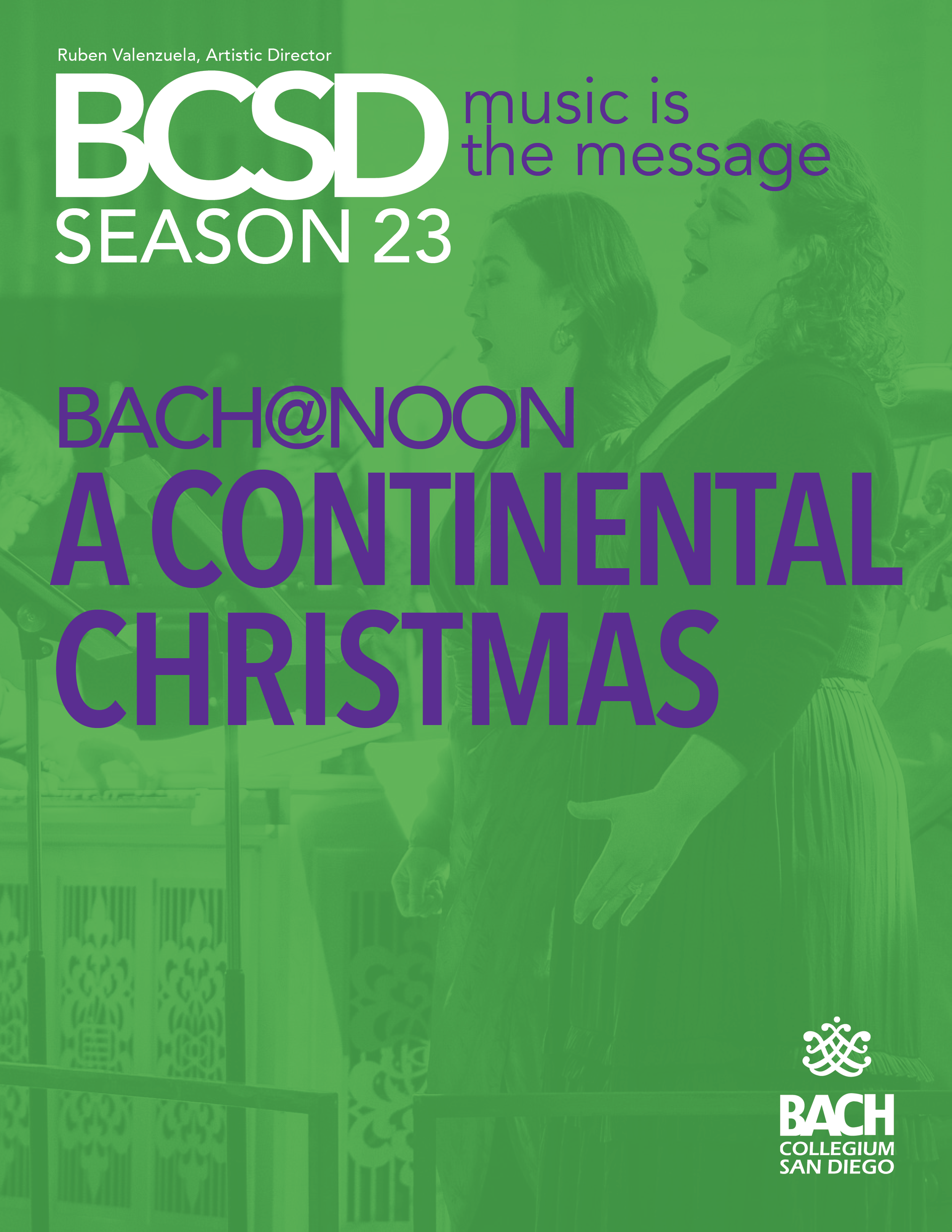BACH AT NOON
Friday, December 12, 2025
12:00 p.m.
BCSD’s 2025-26 Bach at Noon series kicks off with two seasonal rarities: a festive Advent piece by Bach contemporary Christoph Graupner, plus a Christmas cantata by the North German Baroque master Dieterich Buxtehude. These two German-texted works are flanked by selected instrumental music from France and Italy to offer a truly Continental Christmas.
Christoph Graupner
Furcht und Zagen GWV 1102/11b
Dieterich Buxtehude
Fürchtet euch nicht BuxWV 30
Marc-Antoine Charpentier
"La nuit" from In nativitatem Domini canticum, H.416
Francesco Manfredini
Pastorale per il Santissimo Natale
J.S. Bach
Chorale preludes on “Nun komm, der Heiden Heiland” BWV 659 and “Vom Himmel hoch” BWV 700
All Souls’ Episcopal Church
1475 Catalina Blvd, San Diego, CA 92107
GivingBACH Free Community Performance
Friday, December 12, at 5:00 p.m.
Church of the Nazarene in Mid-City
4101 University Ave, San Diego, CA 92105
Friday, January 23, 2026
12:00 p.m.
The fortunes of the clarinet took a dramatic turn for the better toward the end of the 18th century, when W.A. Mozart began writing a series of works featuring it as a solo instrument. Indeed, the Clarinet Quintet K. 581 is one of the absolute high points in Mozart’s entire catalog, heard here alongside five fugues from The Well-Tempered Clavier of J.S. Bach, arranged for string quartet by Mozart himself.
Wolfgang Amadeus Mozart
Five Four-Part Fugues after J.S. Bach’s Well-Tempered Clavier, K.405
Clarinet Quintet in A Major, K.581
Soloist: Joshua Rubin
All Souls' Episcopal Church
1475 Catalina Blvd, San Diego, CA 92107
GivingBACH Free Community Performance
Saturday, January 24, time TBD
San Diego Museum of Art
1450 El Prado, San Diego, CA 92102
Friday, February 20, 2026
12:00 p.m.
The career of Italian composer and cellist Luigi Boccherini (1743-1805) unfolded primarily in Spain, where the more colorful and unique elements of the local musical culture (e.g., dance forms like the fandango and instruments like the guitar) provided a potent inspiration, and a new ingredient, to his suave and elegant lyricism.
Luigi Boccherini
String Quartet in G Major, G.223 “La tiranna”
Selections from Guitar Quintets No. 1 in d minor, G.445, and No. 4 in D Major, G. 448
Soloist: Richard Savino
All Souls' Episcopal Church
1475 Catalina Blvd, San Diego, CA 92107
GivingBACH Free Community Performance
Friday February 20, time TBD
Vi at La Jolla Village
8515 Costa Verde Blvd, San Diego, CA 92122
Friday, April 17, 2026
12:00 p.m.
BCSD returns to the practically bottomless well of forgotten music from the 17th and 18th centuries, with three veritable masterpieces that you are very unlikely to have heard previously (or to ever hear again!), including the North American premiere of J.-H. Fiocco's four-voice motet O beatissima virgo Maria.
Johann Sebastian Bach (ascribed)
Overture in g minor, BWV 1070
Nicolaus Bruhns
De profundis
Joseph-Hector Fiocco
O beatissima virgo Maria
All Souls' Episcopal Church
1475 Catalina Blvd, San Diego, CA 92107
GivingBACH Free Community Performance
Friday, April 17, at 4:30 p.m.
San Diego Public Library, San Ysidro Branch
4235 Beyer Blvd, San Diego, CA 92173





